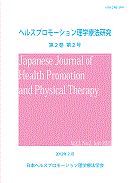Volume 6, Issue 3
Displaying 1-7 of 7 articles from this issue
- |<
- <
- 1
- >
- >|
ORIGINAL ARTICLES
-
2016Volume 6Issue 3 Pages 105-109
Published: September 30, 2016
Released on J-STAGE: October 22, 2016
Download PDF (371K) -
2016Volume 6Issue 3 Pages 111-116
Published: September 30, 2016
Released on J-STAGE: October 22, 2016
Download PDF (387K) -
2016Volume 6Issue 3 Pages 117-121
Published: September 30, 2016
Released on J-STAGE: October 22, 2016
Download PDF (74K) -
2016Volume 6Issue 3 Pages 123-126
Published: September 30, 2016
Released on J-STAGE: October 22, 2016
Download PDF (326K) -
2016Volume 6Issue 3 Pages 127-131
Published: September 30, 2016
Released on J-STAGE: October 22, 2016
Download PDF (368K)
SHORT REPORT
-
2016Volume 6Issue 3 Pages 133-137
Published: September 30, 2016
Released on J-STAGE: October 22, 2016
Download PDF (360K) -
2016Volume 6Issue 3 Pages 139-143
Published: September 30, 2016
Released on J-STAGE: October 22, 2016
Download PDF (559K)
- |<
- <
- 1
- >
- >|
